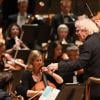
In what was undisputedly the orchestral highlight of Santa Barbara’s concert season, the London Symphony Orchestra transformed the Granada Theatre into a gilded room of worldly proportions on Thursday night. A holy alliance of acronyms converged to make it all possible. To manage the Londoners’ visit, MAW (Music Academy of the West), celebrating its 75th anniversary and currently engaged in an ongoing partnership with the LSO, collaborated with CAMA (Community Arts Music Association of Santa Barbara), which has hosted orchestras and chamber music for over a century.
As expected, Simon Rattle held forth in a masterfully realized symphonic evening. More than other classical events in town this syncopated season, LSO night felt like a triumphant post-pandemic return to cultural normalcy. With Rattle’s sure command, the orchestra made a bold impression from start to finish.
The musical selections were well-contrasted, stylistically, and almost free of standard fare. Among other crosstalk in the program design, the sinuous liquidity of Jean Sibelius’s Seventh Symphony (1924) yielded to the spiky expressionistic intensity of Bela Bartók’s The Miraculous Mandarin (1926), with Maurice Ravel’s dizzily slaloming La Valse (1920) to close.
Following the brisk-meets-atmospheric spread of Hector Berlioz’s Ouverture: Le coursaire (The privateer), the LSO pivoted sharply toward the alluring contemporary fare of The Spark Catchers, by Hannah Kendall. The British composer, born in 1984 and now based in New York, based her brief but impactful 2017 work on a poem by Lemm Sissay, relating the saga of female Olympians to the story of women employed in the dangerous job of catching sparks in a London match factory.

Suitably, elements of both the clanking rhythms of factory life and the characteristics of heat, industry, and lurking peril are imaginatively funneled into a post-minimalist piece. The score also demonstrates this inventive composer’s painterly use and rethinking of the orchestral palette. What opens with simmering, skittering, rhythmic equations ends with a dense sonic thicket of the work’s climactic section, “The Matchgirls’ March,” which celebrates the workers’ strike at the factory in 1888. Heroism meets shades of anarchy, in visceral musical terms.
Sibelius’s once relatively obscure Seventh Symphony has been rediscovered in Southern California thanks to Sibelius-championing Esa-Pekka Salonen’s long tenure helming the Los Angeles Philharmonic. Even so, hearing the LSO’s take on the Symphony No. 7 in this hall was a precious rarity. Gravitas and Nordic-cool poetry meet and mingle in the score, which presents its six movements in one united flow. And “flow” is the operative term in this fluidly morphing and mercurial invention, which challenges any orchestra to find a balance of structure and shifting focus. Rattle and company managed the feat with aplomb.

A very different aesthetic strategy is required to adapt to the spirit of Ravel’s delectably subversive La Valse, one involving both an embrace of the essential waltz spirit and its careful deconstruction. This performance achieved its fiendish double duty, with a beautifully etched, lucid presence and refined detailing that ultimately descended into inebriated abandon by work’s end.
Coincidentally, young British pianist sensation Benjamin Grosvenor had served up the piano version of La Valse just a week earlier, in his Santa Barbara debut at the Lobero Theatre, also presented under the CAMA umbrella. The close proximity and radical variations of the two versions made for a fascinating comparison-contrast experience for CAMA-goers.
The LSO capped off the evening with an encore from Dvořák’s Slavonic Dances. From the podium, Rattle joked that the piece, post-La Valse, was played “just to prove that a dance doesn’t have to go straight down to hell.” Alas, it also felt anticlimactic and out of character after such a thrill ride of a concert. But it left us humming.




